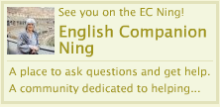During a pop-in visit with the 8th grade social studies teachers last week, the discussion turned to the growing number of interruptions to the school calendar because of the snow cancellations and delays we are experiencing here in Connecticut this winter. The teachers were grumbling, frustrated that they were not able to cover the content in the curriculum units.
“There are some advantages to ice and snow this winter,” I suggested.
They looked at me skeptically.
“Our students are feeling the same conditions that the Continental Army felt that winter at Valley Forge,” they paused.
I continued, “I can’t imagine how teachers in San Diego get students to understand what it was like to be a soldier in that winter in 1778.”
Of course, imagine is the key word here. Students taking classes in sunny 75 degree weather would have to imagine the conditions penned by George Washington to then New York Governor George Clinton from his headquarters in a chilly farmhouse at Valley Forge. Our first Commander-in-Chief’s desperation to keep his troops fed and clothed in frigid conditions is clearly evident in this letter, written while the well-stocked British troops camped comfortably nearby in Philadelphia. During that encampment at Valley Forge beginning on December 19, 1777, nearly 2,500 American soldiers, a quarter of the Continental Army, succumbed to disease and exposure by the end of February 1778. A modified version of Washington’s letter for students (Created through the TAH Making History Grant) appears below:
To Governor George Clinton
Head Quarters, Valley Forge, February 16, 1778
Dear Sir:
It is with great reluctance, I trouble you … For some days…, there has been…a famine in camp. A part of the army has been a week, without any kind of flesh, and the rest for three or four days. Naked and starving as they are, we cannot enough admire the incomparable patience and fidelity of the soldiery, that they have not been [led]…by their sufferings, to a general mutiny…
…I am, on my part, putting every engine to work, that I can possibly think of, to prevent…fatal consequences…. I am calling upon all those, whose stations and influence enable them to contribute their aid upon so important an occasion; … I expect every thing within the compass of your power, and that the abilities and resources of the state over which you preside, will admit….
Valley Forge was not Washington’s first test of endurance in harsh winter conditions. Two years previous to this encampment, Washington had successfully crossed the Delaware River in a surprise attack against the Hessian forces in Trenton, New Jersey. Taking advantage of the Hessian’s late night holiday celebration, Washington crossed the icy waters on December 25, and attacked on the following morning.
Washington’s trip across the icy waters was immortalized in the painting Washington Crossing the Delaware by Emanuel Leutze, (Metropolitan Museum of Art-NYC, 1851).
Washington Crossing the Delaware is also the name and subject of a sonnet by David Shulman (1936). This sonnet is entirely composed of anagrams, or verses of word play, where the letters of a word or phrase are used (once) to produce a new words or in Shulman’s case, verses:
A hard, howling, tossing water scene.
Strong tide was washing hero clean.
“How cold!” Weather stings as in anger.
O Silent night shows war ace danger!The cold waters swashing on in rage.
Redcoats warn slow his hint engage.
When star general’s action wish’d “Go!”
He saw his ragged continentals row.Ah, he stands – sailor crew went going.
And so this general watches rowing.
He hastens – winter again grows cold.
A wet crew gain Hessian stronghold.George can’t lose war with’s hands in;
He’s astern – so go alight, crew, and win!
The nation’s tribute to George Washington, combined his birthday (2/22) with Lincoln’s birthday (2/12) to make President’s Day, a National Holiday celebrated from the frigid shores of the Delaware River, across those same fields of Valley Forge, and all the way to the warm sunny beaches of the San Diego coastline.
The combination of Washington’s letter to George Clinton, the famous painting by Emanuel Leutze, and the sonnet by David Shulman can help students everywhere in the United States to imagine the severe weather conditions of these most famous exploits of Washington, but the students here in the Mid-Atlantic and in New England have the historical advantage to experience that same weather first-hand every year.
Here in Connecticut, in the winter of 2015, our students’ empathy lies with George.







As a teacher of middle-school students, I appreciate all the information you’ve shared, awesome post and I will share with both colleagues & students. Thank you for this thought-filled post. You’re right, those in San Diego must only imagine!
I was amazed that the sonnet is an anagram. Didn’t know that!
One of the most important faculties of mind — imagination — which enables empathy and deep understanding…in every teacher’s personal common core, but nowhere to be found in the capital-letter Common Core…